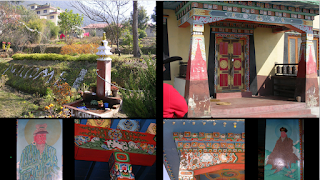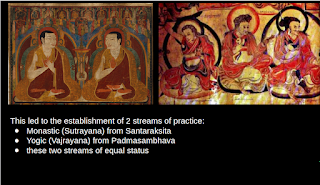Nor'dzin explained that there were three main reasons why she, her husband, and other members of her Buddhist lineage made these pilgrimages. The first reason was to visit Tibetan and Bhutanese teachers with whom they had connections, and to make new contacts with other teachers.
The second reason for embarking on pilgrimage was to experience 'Buddhism as ordinary'. Nor'dzin said that this was important for people brought up in a country where Buddhism was not the religion of the culture. It was important to establish that one's interest in Buddhism and Buddhist practice was real and not just a fantasy because it felt unusual and exotic. One way in which pilgrims experience everyday practice in Kathmandu, Nepal, is to join the local people and other practitioners for kora. Kora is the circumambulation of a sacred place. Boudanath is a small town which used to be surrounded by fields up until the late 1970s, but has now been subsumed by the city of Kathmandu. The Great Chörten (Stupa), built in the 6th century is the focus for kora in Boudanath.
Nor'dzin then described a long hike to a nunnery called Nagi Gompa, in the Himalayan foothills (3,200m), and visits to monasteries.
She explained a particular personal interest in an image that is usually painted on the outside wall of a place of practice. This image is called 'The Wheel of Life' and pictorially exemplifies the fundamental teachings of Buddhism. Eventually she commissioned her own thangka (painting on cloth) of this image and used it to illustrate her book 'Travelling at the Speed of Mind' about this teaching.
The third reason for her pilgrimages was to 'address an historical prejudice'. Nor'dzin talked a little about the history of Buddhism in Tibet to introduce this topic. The 'first spread' of Buddhism occurred in the 8th century instigated by King Trisong Détsen. Two streams of Buddhism were established: Padmasambhava's Red Sangha (monastic community) and Shantarakshita's White Sangha (non-monastic, yogic community) and they were considered equal at that time. The Red Sangha are monks and nuns, wear red skirts and shave their heads as a symbol of renunciation. The White Sangha are non-monastic yogis and yoginis, wear white skirts and never cut their scalp hair as a symbol of embracing everyday life as practice.
Then about 100 years later a king suppressed Buddhist practices, destroying monasteries and persecuting practitioners. This led to practitioners retreating to the outer regions of the Tibetan Empire, which at that time included areas of Nepal, Bhutan and northern India. Buddhism returned to royal favour in the 11th century and two new schools were established, but with an emphasis on monasticism as the preferred style. This was the 'second spread' of Buddhism in Tibet. The original form of Buddhism became known as the 'Nyingma', meaning 'Ancient Ones'. The trend toward favouring monasticism was compounded in the 14th century with the creation of a new, entirely monastic school of Buddhism, and with both spiritual and political power and wealth becoming invested in this school. The White Sangha came to be regarded as disreputable and undesirable by those favouring the dominant monastic school, but nevertheless continued to the present day.
In Bhutan, Buddhism was never suppressed, and the wholly-monastic school never arose, so the religion practised in Bhutan is still from the 'first spread' where the Red and White Sanghas are regarded of equal value. Nor'dzin explained that her lineage is Nyingma, and White Sangha, so it is most valuable to go to a country and experience Buddhism without the historical prejudice against the White Sangha that developed in Tibet.
Nor'dzin talked about her two trips to Bhutan. On the first trip they flew to central Bhutan and then drove back to Paro in the west, visiting many places on the way. On the second pilgrimage they flew to eastern Bhutan and stayed there for a few days at Chador Lhakang before returning to Paro. A lhakang is a place of practice for Red and White sanghas.
She highlighted two other places of particular interest near Paro: a 15th century suspension bridge created by 'the Da Vinci of the East', Thantong Gyalpo; and a steep climb to Taksang (Tiger's Nest).
She finished with a few whimsical photographs of interesting hats available to purchase in Kathmandu!



















No comments:
Post a Comment